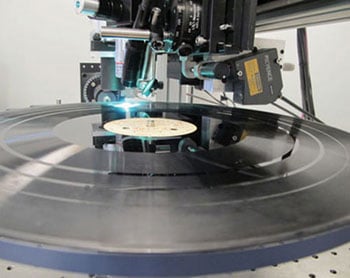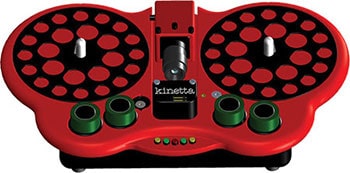
Digitization can be a complex task, especially when fragile or obsolete media are a part of your collections. These services aim to simplify the process.
Document capture at Crowley Imaging Services
The Crowley Company has been providing micrographic and digital archiving services for more than 30 years. Crowley Imaging Services uses equipment from its own manufacturing arm and other vendors to offer services to libraries and archives that don’t have an in-house digitization department. The company recently purchased two Phase One IQ3 100MP digital back camera systems, which include the first 100-megapixel sensor. The cameras have a larger field of view, higher-resolution scans, and advanced color-management, capturing a wide range of materials with precision and accuracy.
Its imaging services focus solely on document and data capture and include paper scanning, bound book scanning, archival preservation scanning, micrographics, and image hosting and viewing. Pricing is based on project size and scope. The baseline for production-level projects is 50,000 images, which allows for volume pricing; however, projects of all sizes are considered. For collections that cannot be easily transported, Crowley offers onsite imaging services.
More information on Crowley Imaging Services is available at thecrowleycompany.com/imaging-services.
Audio preservation at Northeast Document Conservation Center

The Northeast Document Conservation Center (NEDCC) is known for preservation and restoration of paper-based collections. In recent years, it has expanded its audio preservation services to include cutting-edge technologies. In 2014, NEDCC began offering IRENE imaging, which uses high-resolution digital imaging to capture sound information on grooved recording media such as wax cylinders and records. Specialized software then extracts audio information from the images, allowing even audio that would otherwise be unplayable to be digitized.
More traditional, stylus-based digitization is also available, and its audio preservation services have recently expanded to include other audio formats, including film and magnetic tape, making it an ideal resource for institutions with audio collections that have yet to be digitized. Media submitted for digital transfer can also be cleaned, rehoused, and repaired, and paper containers and manuscript materials that are provided with the audio can be digitized.
Cost estimates are tailored to specific projects and may require the submission of sample materials. NEDCC maintains a list of current grant opportunities for audio preservation. Consulting services, including collection-level assessment, workshops, and webinars are also available.
For more information on NEDCC audio preservation services, visit nedcc.org/audio-preservation.
Film digitization with the Kinetta Archival Film Scanner

The Kinetta Archival Film Scanner, invented by filmmaker Jeff Kreines, is designed to create high-resolution scans, especially of damaged and fragile films. A simple but highly adjustable system passes the film through particle transfer rollers, which clean and drive the film before it passes over a curved gate that allows even warped film to lie flat on the scanning surface. Together the scanner head, optics, and gates allow full edge-to-edge image scanning. It accepts a wide range of sizes and formats, including negative and reversal film.
The full system, including a capture computer with proprietary software and 16 TB of memory, gates for 8, 16, and 35 mm film, and installation and training, is available for $129,995. A more basic version, with a base price closer to $40,000, is slated for release in 2017, allowing libraries and archives with a smaller film digitization budget to take advantage of this technology. It provides the same scanning capabilities but does not scan 35 mm film and does not include a capture computer.
For more information on the Kinetta Archival Film Scanner, visit kinetta.com.
Archiving and Access with Preservica Cloud Edition

User: Sarah Hayes, digital archivist, the Trustees of Reservations, Archives and Research Center, Sharon, Mass.
Product: Preservica Cloud Edition (CE)
Details: Preservica CE is a cloud-hosted preservation and public access platform that allows small institutions to provide access to resources without local IT support or servers.
How do you use Preservica CE?
The Archives and Research Center (ARC) uses Preservica CE for two main functions. First, it is an OAIS (open archival information system)-compliant digital preservation system that has allowed us to begin providing the same care for our digital materials as we do for our physical collections. We also use Preservica’s public-facing component, Universal Access, to host our online collections catalog (thetrustees.org/collections).

How does Preservica CE serve your archive’s needs?
Preservica’s expansive preservation capacity makes it possible for ARC to responsibly collect and protect the many types of digital assets at the Trustees. Furthermore, Universal Access has solved a major obstacle for us: how to provide access to our collections and increase the opportunities for discovery. Using the WordPress framework, we have launched an online collections catalog and, with responsive design, the catalog can be used on a range of devices.
What are the main benefits?
Like many small nonprofits, the Trustees currently does not have a large in-house IT team, and we’re not in a position to host our own site. Preservica CE is fully hosted, and the support service has been an invaluable resource. With Preservica doing the heavy lifting for hosting, support, and maintenance, our team is able to focus on expanding and processing new collections, creating catalog records in PastPerfect, and adding more content to the online catalog. Through Preservica, we are able to protect, manage, and share our collections with one system.
What would you like to see improved or added to the service?
Universal Access does not offer as many customization options as we would like, and there are ways in which the design is not as user-friendly as it could be. However, part of why we selected Preservica was its dedication to evolving along with its customers and industry standards. Based on feedback from the user community, the company has begun designing an improved release of Universal Access.


